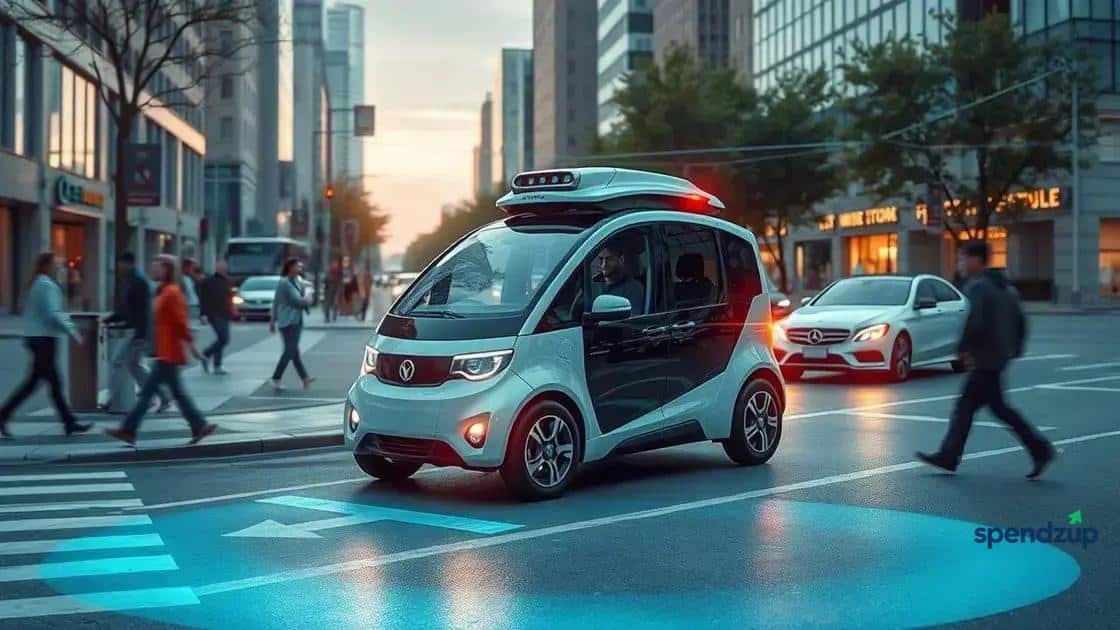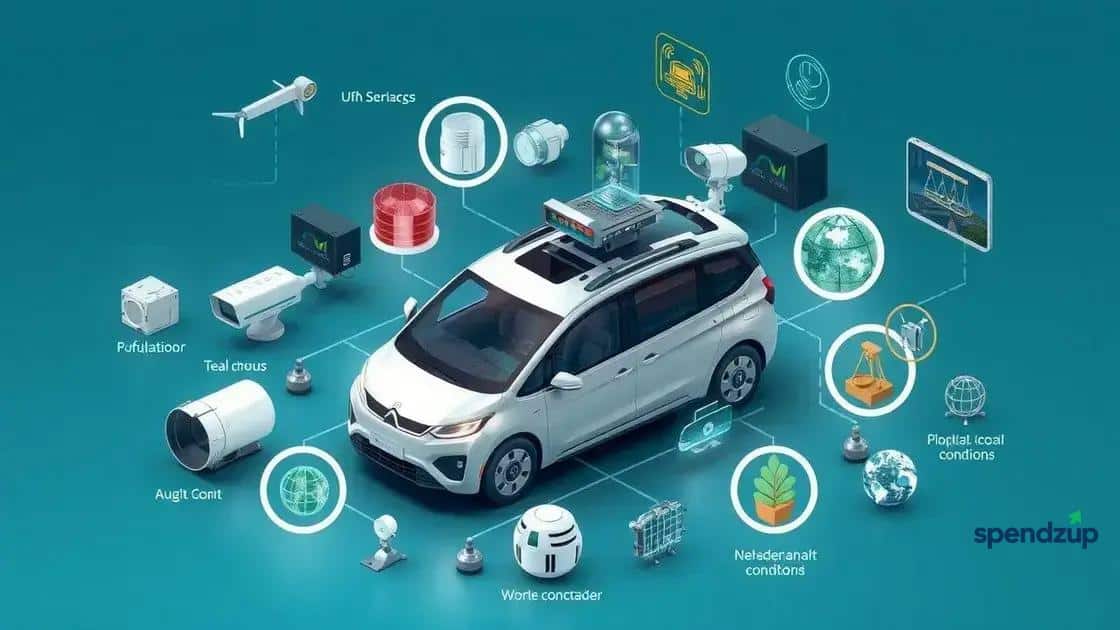Autonomous Driving Data: Unlocking The Future Of Transportation

Autonomous driving data is essential for how self-driving vehicles understand their environment, navigate safely, and make real-time decisions, leveraging advanced sensors and analytics to improve performance and safety.
Autonomous driving data is fundamentally changing how we think about transportation. Have you ever wondered how this data is utilized to make our roads safer and more efficient? In this article, we’ll dive into its significance and future potential.
Understanding autonomous driving data
Understanding autonomous driving data is essential for grasping how self-driving cars function. This data helps vehicles perceive their surroundings and make decisions. As we delve into this topic, you’ll see how it all fits together.
What is autonomous driving data?
Autonomous driving data includes information gathered from various sensors and systems within the vehicle. This data allows the car to understand its environment, detect obstacles, and navigate safely.
Types of data utilized
- Sensor data: Information from cameras, LiDAR, and radar.
- GPS data: Helps in determining the vehicle’s position.
- Map data: Provides detailed information about the road network.
- Vehicle telemetry: Monitors performance and behavior of the vehicle.
This blend of data ensures that autonomous vehicles can make real-time decisions. For instance, when approaching an intersection, the data from sensors detects nearby cars and pedestrians, allowing the vehicle to decide whether to stop or proceed.
Another important aspect of understanding autonomous driving data is its role in machine learning. By analyzing vast amounts of driving data, these systems can learn from past experiences. This learning helps the vehicle adapt to new situations it might encounter on the road.
Data collection challenges
Collecting accurate data is crucial yet challenging. Weather conditions, varied terrains, and urban infrastructure can all affect data accuracy. To ensure safety and efficiency, ongoing improvements in data collection techniques are necessary.
In summary, understanding autonomous driving data is key to unlocking the full potential of self-driving technology. It enables vehicles to navigate effectively and safely, continually learning and adapting as they collect more information.
How data enhances vehicle safety

Data plays a crucial role in enhancing vehicle safety, especially in the context of autonomous driving. By leveraging vast amounts of data collected from various sensors, vehicles can make informed decisions that significantly reduce the risk of accidents.
Real-time data analysis
Through advanced algorithms, real-time data is analyzed to assess the vehicle’s environment. This enables the car to respond promptly to sudden changes, such as pedestrians crossing the road or vehicles making unexpected maneuvers.
- Immediate reaction to hazards.
- Adaptive speed control based on traffic conditions.
- Awareness of blind spots.
- Enhanced collision avoidance systems.
As a result, vehicles equipped with such capabilities can minimize the likelihood of collisions, thereby improving overall road safety.
Learning from past incidents
In addition to real-time data, autonomous vehicles also learn from historical data. By analyzing past incidents and near-misses, these systems improve their algorithms. This ongoing learning process helps prevent similar incidents in the future.
For instance, if a specific maneuver led to a near-collision in the past, the system can adjust its decision-making process. This iterative enhancement cultivates a safer driving experience for everyone on the road.
Moreover, incorporating vehicle-to-vehicle communication allows cars to share critical safety information. When one vehicle detects a potential hazard, it can inform others nearby, providing an extra layer of safety. This connectivity is vital in preventing accidents and ensuring safer navigation.
Through these mechanisms, data not only enhances the immediate safety of vehicles but also contributes to a safer driving ecosystem as a whole. As technology evolves, the integration of data will continue to pave the way for improved vehicle safety standards.
The role of data in navigation systems
The role of data in navigation systems is vital, especially for autonomous vehicles. It helps ensure efficient and safe travel by providing real-time information about routes, traffic, and environmental conditions.
Types of data used in navigation
Navigation systems rely on various sources of data to function correctly. These include:
- GPS data: Essential for determining the vehicle’s location.
- Map data: Provides road layouts, traffic signals, and relevant landmarks.
- Traffic data: Updates on current traffic conditions and potential delays.
- Sensor data: Information from vehicle sensors that detects surrounding obstacles.
This combination of data allows autonomous vehicles to navigate efficiently and safely. For example, if there is heavy traffic on a route, the navigation system can quickly reroute the vehicle to avoid delays.
Real-time updates
One of the significant advantages of data in navigation systems is the ability to offer real-time updates. This means the system can adjust routes instantly based on changing conditions. For instance, if an accident occurs on the planned route, the vehicle can use real-time data to find an alternative path.
Additionally, navigation systems can learn from previous trips. By analyzing past journeys, they can recommend more efficient routes, improving travel times over time. This learning capability is essential for adapting to patterns, such as rush hour traffic.
Furthermore, the integration of machine learning techniques enhances navigation accuracy. As more data is collected over time, these systems can predict potential traffic issues and optimize routes before the vehicle even starts moving.
In conclusion, the role of data in navigation systems cannot be overstated. It ensures that autonomous vehicles navigate safely and efficiently, adapting to real-time conditions while learning from past experiences.
Challenges in collecting autonomous driving data

Collecting autonomous driving data comes with several challenges that impact both the efficiency of data gathering and the reliability of the systems using it. These challenges are essential to understand for improving the technology.
Environmental factors
One major challenge is the impact of environmental conditions. Rain, fog, snow, and even bright sunlight can affect sensor performance. For instance, heavy rain can obscure camera views, while fog can disrupt radar signals.
- Sensor accuracy can decrease in poor weather.
- Visibility issues may lead to inconsistent data collection.
- Time of day can also change data interpretation.
Due to these factors, autonomous vehicles must be equipped with advanced sensors that can operate effectively in varying conditions.
Data integration challenges
Another significant issue is integrating data from multiple sources. Autonomous vehicles rely on various sensors, including cameras, LiDAR, and radar. Each type of sensor has its own data format and processing requirements.
To achieve accurate analysis, data fusion techniques are necessary. These techniques combine inputs from different sensors to create a comprehensive understanding of the environment. However, merging this data can be complex and time-consuming.
Legal and privacy concerns
Furthermore, collecting data raises legal and privacy issues. As vehicles gather information about their surroundings, they may record personal data without consent. This can lead to significant legal issues and public concern regarding privacy.
To address these challenges, companies must implement strict data governance policies. They should ensure compliance with local laws while protecting users’ privacy, an essential aspect of gaining public trust.
Lastly, the sheer volume of data generated presents its own set of challenges. Autonomous vehicles create massive amounts of data that need to be stored, processed, and analyzed effectively. Managing this data efficiently is crucial for improving the performance and safety of these systems.
Future trends in autonomous driving data
The future of autonomous driving data is exciting and filled with possibilities. As technology advances, we can expect significant improvements in how data is collected, analyzed, and utilized in self-driving vehicles.
Enhanced data collection methods
One major trend is the development of more sophisticated data collection methods. Future vehicles will likely use a combination of advanced sensors and artificial intelligence to gather more accurate data. This includes enhanced camera systems and improved LiDAR technology.
- High-definition mapping for precise location tracking.
- Smarter sensor arrays that adapt to environmental conditions.
- Expanded vehicle-to-vehicle communication for real-time data sharing.
These advancements will allow autonomous vehicles to sense their surroundings better, leading to safer driving experiences.
Integration of big data and analytics
Another trend is the integration of big data and sophisticated analytics. As vehicles generate massive amounts of data, leveraging this information will be crucial. Analytics can help identify patterns and trends that improve vehicle response times and navigation systems.
Data analytics will also assist manufacturers in understanding driver behavior and preferences, enabling them to create personalized driving experiences. By analyzing feedback and performance data, companies can continually enhance autonomous systems.
Regulatory changes and standards
As the technology evolves, we can expect regulatory changes that will shape the future of autonomous driving data. Governments will likely develop new regulations to ensure safety and privacy while promoting innovation. These regulations will address the use of data and establish standards for data sharing among manufacturers.
Lastly, issues related to cybersecurity will gain more attention. Protecting data from cyber threats is essential as more vehicles become interconnected. Future trends will focus on developing robust cybersecurity measures to protect sensitive information and ensure consumer trust.
Overall, the future of autonomous driving data holds great promise, as advancements in technology will pave the way for safer, more efficient self-driving vehicles.
In summary, the future of autonomous driving data is bright
As we discussed, advancements in technology will transform how data is collected and used in self-driving vehicles. Enhanced sensors, big data analytics, and updated regulations will all play crucial roles.
These trends will lead to safer and more efficient autonomous systems, providing a better driving experience. It is essential to address challenges such as data privacy and cybersecurity as we move forward.
By embracing these advancements, the future of transportation can become smarter, more connected, and safer for everyone on the road.
FAQ – Frequently Asked Questions about Autonomous Driving Data
What role does data play in autonomous driving systems?
Data is crucial for autonomous driving systems as it helps vehicles understand their surroundings, navigate efficiently, and make real-time decisions to ensure safety.
How do environmental conditions affect data collection in autonomous vehicles?
Environmental factors like rain, fog, and snow can impact sensor performance, making it challenging to gather accurate data, which is essential for safe navigation.
What are some future trends in autonomous driving data?
Future trends include enhanced data collection methods, the integration of big data analytics, and improvements in regulatory standards to ensure safety and privacy.
What challenges are associated with collecting autonomous driving data?
Challenges include environmental factors, data integration from different sensors, legal issues regarding privacy, and the sheer volume of data generated by vehicles.





